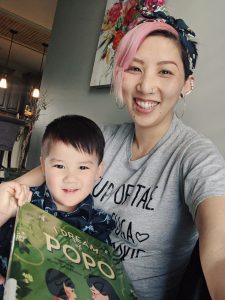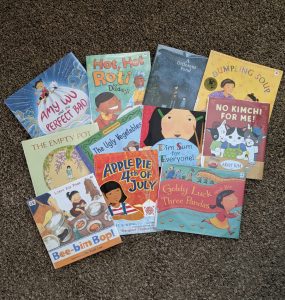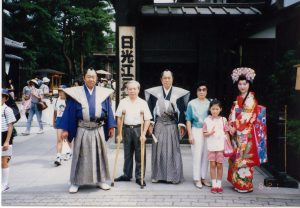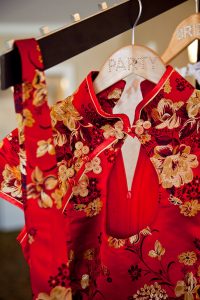May is AAPI (Asian American Pacific Islander) Heritage Month! Since 1990, this is a month that recognizes and celebrates the contributions and influence of Asian Americans and Pacific Islander Americans in the U.S. It’s a time to learn and explore AAPI history, culture, and achievements. Fun facts: The month of May also commemorates the immigration of the first Japanese people to the United States on May 7, 1843. May also marks the completion anniversary of the transcontinental railroad on May 10, 1869. The majority of the workers who laid the tracks for the railroad were Chinese immigrants.

One of the most important things to me, as an Asian American, is representation. The reality is we don’t see enough Asian representation in the U.S. I want my kids to see people who look just like them, hear their stories, identify and relate. Books are a great way to show kids that the world is full of diverse people, different languages, and varying cultures.
Here is a list of some of our favorite books showing Asian representation, geared toward young children.
Warning: You might get hungry after reading some of these, as many revolve around food! Asian families, like many others, show love by going way of feeding your belly!
- Bee-bim Bop!
A hungry girl helps her mother bibimbap, a traditional Korean rice dish mixed with vegetables, meat (usually beef), and gochujang. Together, mother and daughter go through the steps of shopping, prepping ingredients, setting the table, and finally sitting down to enjoy the meal as a family. It’s a fun read with rhyming text that kids will appreciate. As an added bonus to the sweet story, the author includes her own bibimbap recipe! - Dumpling Soup
The story of Marisa and her family is set in Hawaii. Every year for the New Year celebration, she helps make dumplings. But she worries if anyone will eat her funny-looking dumplings. Dumpling Soup celebrates food, customs, and languages of mixed families.
- Dim Sum for Everyone!
For a young girl, having dim sum with family is filled with fond memories. Dim sum restaurants are lively and bustling with energy from families ready for delicious food. At the dim sum restaurant, a family selects their favorite dishes from the rolling carts filled with dumplings, cakes, buns, and tarts. Everyone enjoys the food “family style,” having a little bit of everything.  A Different Pond
A Different Pond
This children’s book is about a family who comes to the U.S. from Vietnam, as refugees. As a young boy, Bao Phi awoke early, hours before his father’s long workday began, to fish on the shores of a small pond in Minneapolis. The fish they caught was for food, not recreation. A successful catch meant a fed family. As they fished, Bao’s father told him about a different pond in their homeland of Vietnam.- Goldy Luck and the Three Pandas
In this Chinese American retelling of Goldilocks and the Three Bears, a careless Goldy Luck wreaks havoc on the home of a family of panda bears. She eats up the littlest panda’s rice porridge, breaks his rocking chair, and rumples all the blankets on his futon. When Goldy takes responsibility for her actions, she makes a new friend just in time for Chinese New Year. - Apple Pie 4th of July
It’s Independence Day. A Chinese-American girl is shocked that her parents are cooking Chinese food to sell in their family restaurant on this all-American holiday. She tries to tell her parents how it is unacceptable, but ultimately comes to another realization and learns a valuable lesson. This a great book celebrating cultural diversity. - No Kimchi for Me!
This story about a Korean-American family will appeal to picky eaters and budding foodies alike, as it celebrates family, food, and growing up in Korean culture. Yoomi loves Grandma’s cooking, except the kimchi because of it’s pungent odor and strong, spicy taste. She is determined to find a way to make kimchi taste better—but not even ice cream can help. At the end of the story, there is information about kimchi and how it’s made, along with a recipe for Grandma’s kimchi pancakes. It’s one of my favorite Korean dishes! - Hot Hot Roti for Dada-ji
The author weaves together many aspects of life in India and contemporary life in the United States. Aneel is a young Indian American boy who shares many adventures with his grandfather, Dada-ji. Dada-ji tells him a story about his childhood that involves hot roti, inspiring Aneel to make some. Together the pair set off to make their own adventures and memories. - The Ugly Vegetables
The author, Grace Lin, also wrote Dim Sum for Everyone!. The Ugly Vegetables shares timeless themes of community and diversity. A neighborhood comes together to share flowers and ugly vegetables soup. The young gardener learns that regardless of appearances, everything has its own beauty and purpose. Complete with a guide to the Chinese pronunciation of the vegetables and the recipe for ugly vegetable soup!
- Amy Wu and the Perfect Bao
Meet the funny, fierce, and fearless Amy Wu. She is determined to make a perfect bao. It takes skill to make the bao look and taste delicious, but Amy’s baos keep coming out all wrong. Her baos are either too small, too large, too full, too empty, or just too messy. She gets frustrated, but there’s a message about persevering and critical thinking. The illustrations are very cute and fun. There’s even a recipe in the back so you can make your own bao. There are so many varieties of baos, but I’ve never met a bao I didn’t love. This made me reminisce of all the times I would watch my grandma fill and wrap baos in the kitchen. The author also wrote another story about Amy Wu, called Amy Wu and the Patchwork Dragon. - I Live in Tokyo

Visiting Japan with my grandparents in the 4th grade. We just finished watching a kabuki, Japanese dance-drama. 7-year-old Mimiko experiences a year of fun, food and festivities in capital of Japan. Tokyo is a busy city of color, activity, celebrations, gigantic buildings, and much more. Month by month, Mimiko enjoys different meals and participates in various Japanese customs, from tea ceremonies to how to put on a kimono. All the food made me hungry and miss my grandpa, who grew up heavily influenced by Japanese culture. He lived in Taiwan when it was under Japanese rule, and spoke fluent Japanese. My childhood became a mixture of American, Taiwanese, and Japanese traditions.
- Uncle Peter’s Amazing Chinese Wedding

My wedding reception qipao, traditional Chinese dress, with a matching tie for my husband. The whole family is looking forward to Uncle Peter’s wedding, except Jenny. While everyone is preparing for the traditional Chinese wedding, Jenny worries that she won’t be Uncle Peter’s number one girl anymore. Maybe she can stop the wedding? This charming picture book highlights many traditions of a Chinese wedding: the tea ceremony, exchanging good-luck money called hóngbāo, and traditional dresses.
- Cora Cooks Pancit
Cora loves being in the kitchen, but she always gets stuck doing the kid jobs like licking the spoon. One day, she finally gets the chance to be Mama’s assistant chef. And of all the delicious Filipino dishes that dance through Cora’s head, she and Mama decide to make pancit, her favorite noodle dish. When dinner is finally served, her siblings find out that Cora did all their grown-up tasks, and Cora waits anxiously to see what everyone thinks of her cooking. - Eyes that Kiss in the Corners
A New York Times Bestseller and #1 Indie Bestseller. This beautiful picture book tells a story about learning to love and celebrate your Asian-shaped eyes. A young Asian girl notices that her eyes look different from her peers’. They have big, round eyes and long lashes. She realizes that her eyes are like her mother’s, her grandmother’s, and her little sister’s. They have eyes that kiss in the corners, such beautiful imagery. The young girl starts to recognize her own beauty and discovers a path to self-love and empowerment. - The Name Jar
Unhei recently moved to the US from Korea, and worries her new classmates won’t be able to pronounce her name. She tells them that she will choose a new/different name later. Her classmates are fascinated by this no-name girl and start filling a glass jar with names for her to pick from. After trying some names, Unhei decides to stick with her real name. The Name Jar is a beautifully illustrated, engaging story about valuing your roots and your uniqueness. This is a book that I just love so much, and never get tired reading to the kids. Both my sons have Chinese middle names, and they make sure people know. - I Dream of Popo
When a young girl and her family emigrate from Taiwan to America, she leaves behind her beloved Popo (grandmother). She misses her Popo every day, and even if their visits are fleeting, their bond is strong. I am of Taiwanese heritage and my grandma (Ah-ma) was my mother figure; she raised me from birth through 7th grade. The story sure made me think of Ah-ma and miss Taiwan, where I spent preschool. This is a book for anyone with immigrant roots, diaspora history, grandparents living or departed, and/or bilingual consciousness. It will touch your heart. Grab the tissues! - Noodle Magic

Beautiful illustrations from Noodle Magic Grandpa Tu is famous for his special noodles. As the emperor’s birthday approaches, he teaches his granddaughter, Mei. Mei struggles to find the magic needed to make noodles. Grandpa Tu patiently helps Mei stretch the dough, watches as she rolls it into a ball, and tosses it towards the Moon Goddess in the sky. The Moon Goddess ultimately helps Mei find her own magic. Mei doesn’t just make noodles, her magic noodles come in different shapes and sizes! The story captures how the grandfather and granddaughter work together to accomplish what one could not do alone.
- Thanking the Moon
The family from Dim Sum for Everyone! are now celebrating the Mid-Autumn Moon Festival. Each member of the family lends a hand as they prepare a moonlit picnic with mooncakes, pomelos, cups of tea, and colorful lanterns. And everyone sends thanks and a secret wish up to the moon. I love that the book includes an informative author’s note with details on the customs and traditions of the Moon Festival.
For more books with Asian representation, Social Justice Books has a great list organized by age group.
















